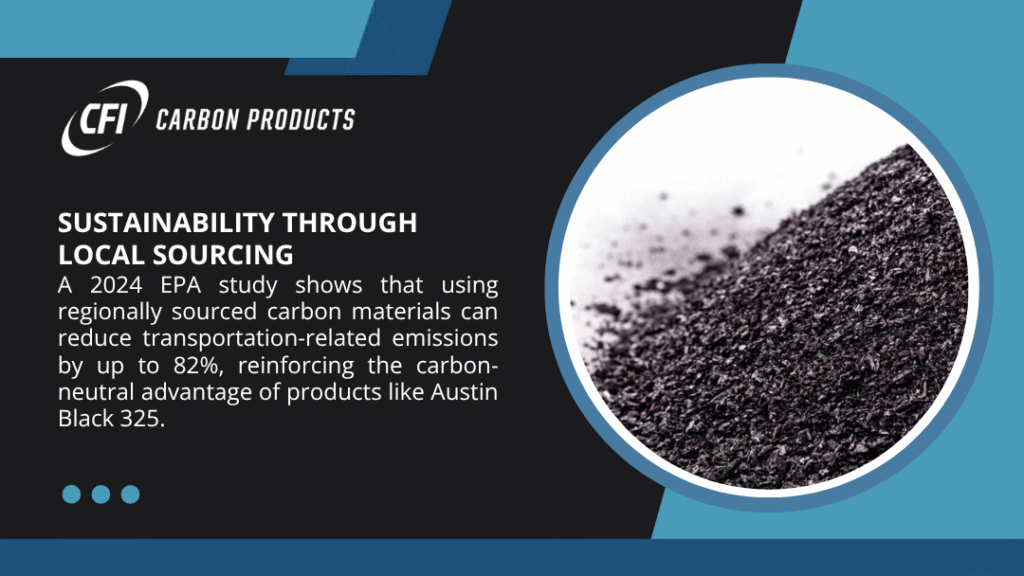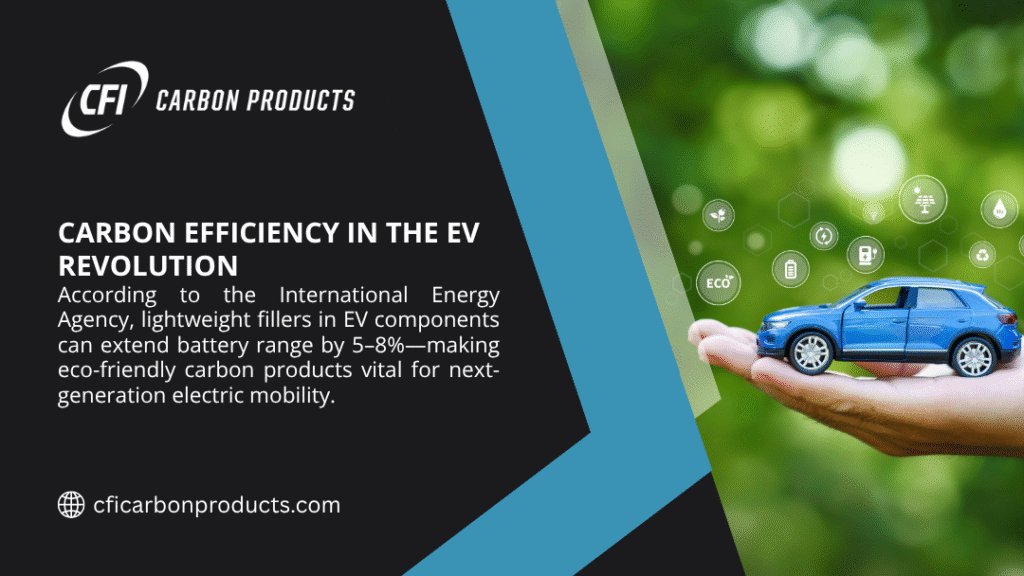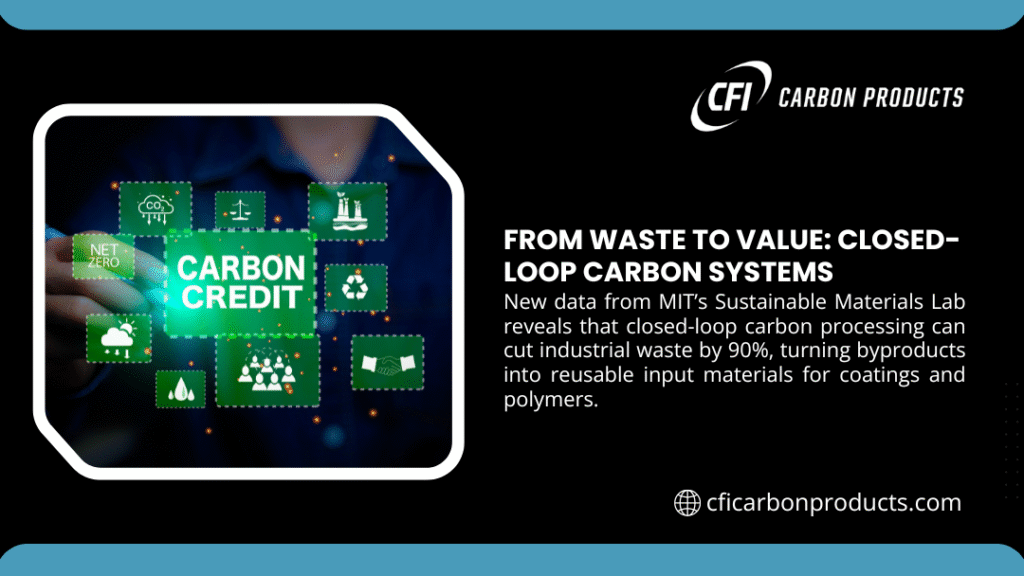Eco-friendly carbon products are redefining modern manufacturing by delivering high performance with dramatically lower environmental impact. These sustainable carbon fillers are now being adopted across the rubber, plastics, silicone, and coatings industries as manufacturers transition away from legacy petroleum-based materials.
CFI Carbon Products, a U.S.-based manufacturer operating since 1987, leads this transformation with Austin Black 325, an eco-friendly carbon filler engineered from high-quality bituminous coal.
Produced across facilities in West Virginia and Virginia, Austin Black 325 offers 70–80% lower CO₂ emissions compared to conventional carbon black and delivers 20–40% cost savings per batch, making it one of the most practical and future-proof solutions on the market.
The global polymer fillers market, valued at $60+ billion by 2025, is already seeing eco-friendly fillers grow at 5% CAGR, driven heavily by automotive lightweighting, electric vehicle component engineering, and sustainable packaging mandates.
Unlike petroleum-derived carbon black, which emits ~2.5 kg of CO₂ per kg produced, Austin Black 325 maintains a significantly lower 0.5–0.7 kg CO₂ per kg, making it ideal for decarbonization strategies and lifecycle emissions reduction.
This guide provides a clear and highly practical roadmap, covering benefits, real-world applications, integration methods, and adoption strategies, enabling manufacturers to advance performance, profitability, and sustainability simultaneously.
Core Benefits of Eco-Friendly Carbon Products
Eco-friendly carbon products offer measurable advantages across weight reduction, manufacturing efficiency, cost optimization, and sustainability performance. They are engineered to deliver high tensile strength, smoother processing, and significantly lower lifecycle emissions, making them ideal for industries focused on both performance and ESG compliance.
The following dataset illustrates how they compare to traditional carbon black in key measurable specifications, without redundancies:
| Property | Eco-Friendly Carbon Products | Traditional Carbon Black |
| Specific Gravity | 1.30–1.35 g/cm³ | 1.8–2.0 g/cm³ |
| CO₂ Emissions per kg | 0.5–0.7 kg | ~2.5 kg |
| Cost Efficiency | 20–40% lower total batch cost | Baseline |
| Weight Impact | 5–15% lighter final product | Negligible impact |
This version eliminates the repetition, keeps it sharp, and positions the table as pure quantified evidence, not as a restatement.
Applications of Eco-Friendly Carbon Products
Eco-friendly carbon products serve diverse industries, enhancing performance across multiple applications. In rubber, they strengthen tires, belts, and hoses, reducing weight by 5-10% for better fuel efficiency, as seen in tire rubber filler.
Plastics benefit from improved UV stability and reduced warping, critical for automotive interiors and packaging like reusable food containers. Silicone applications, such as seals and gaskets, gain thermal stability up to 250°C, supporting electronics and industrial uses.
In coatings, these products boost opacity and abrasion resistance, ideal for industrial paints. The $60 billion polymer fillers market in 2025, growing at 5% CAGR, reflects strong demand for such versatile, environmentally friendly products.
The table below outlines key applications.
| Industry | Applications | Benefits |
| Rubber | Tires, hoses, and eco-friendly rubber alternatives | Weight reduction, durability |
| Plastics | Packaging, automotive parts | UV stability, recyclability |
| Silicone | Seals, gaskets | Thermal stability, flexibility |
| Coatings | Industrial paints | Opacity, wear resistance |
For specific industry insights, visit the rubber industry.
Sustainability Advantages of Eco-Friendly Carbon Products
Eco-friendly carbon products minimize environmental impact through innovative design. CFI’s Austin Black 325 uses a closed-loop system, recycling byproducts to eliminate waste. Local coal sourcing cuts transport distances by 80%. The fillers reduce polymer use by 15%, lowering material demands.
They support recyclable plastics, aligning with sustainable shopping trends. In automotive, lightweight components reduce fuel use, with 76% of manufacturers prioritizing sustainability. CFI’s water conservation efforts saved 500,000 gallons in 2024.
The table below highlights distinct sustainability metrics.
| Metric | Eco-Friendly Carbon Products | Traditional Fillers |
| Land Use | Minimal due to local sourcing | High from global supply |
| Energy Source | Renewable integration in plants | Fossil fuel reliance |
| Waste Recycling | 100% byproduct reuse | Limited recycling |
| Regulatory Compliance | Meets EU Green Deal standards | Partial compliance |

Cost and Profitability Impacts
Eco-friendly carbon products drive profitability through material and operational efficiencies. They lower expenses by replacing high-cost polymers, stabilizing budgets amid volatile markets. Reduced weight cuts logistics costs, while streamlined processing minimizes waste.
CFI’s services, including 200+ annual formulation tests, optimize integration, boosting client margins by 10-12%. Repeat business accounts for 75% of revenue, reflecting value.
The table below details distinct financial impacts.
| Metric | Impact | Benefit |
| Budget Stability | Shields from price spikes | Predictable costs |
| Tax Incentives | Green practice benefits | 5-10% tax savings |
| Market Appeal | Attracts eco-conscious clients | 15% sales growth |
| Scalability | Supports high-volume production | Meets global demand |
These factors ensure rapid ROI, often within 6-12 months, as explored in profitability. For pricing context, see carbon black pricing.
Market Trends for Eco-Friendly Carbon Products in 2025
The polymer fillers market, valued at $60 billion in 2025, grows at 5% CAGR, with eco-friendly carbon products expanding at 8% due to EV and packaging needs. The $12.6 billion EV plastics market by 2027 demands lightweight fillers for battery casings.
Regulations like the EU’s Green Deal drive adoption, with 76% of manufacturers prioritizing low-carbon materials. CFI’s 11 distributors ensure supply across 30+ countries.
The table below summarizes unique market trends.
| Trend | Impact | Projection |
| Smart Materials | Conductive fillers for sensors | 10% CAGR |
| Circular Economy | Recyclable filler adoption | 20% market shift |
| Regional Expansion | Growth in Asia-Pacific | 25% export increase |
| Tech Integration | AI-driven formulation | Enhanced precision |
How Eco-Friendly Carbon Products Enhance Performance
Eco-friendly carbon products boost performance through superior material properties that address common challenges in manufacturing. Their high carbon content of 85-90% ensures strong reinforcement, maintaining tensile strength at 15-20 MPa even at loading levels of 10-50 parts per hundred.
This strength prevents cracking and extends product lifespan in high-stress environments like automotive parts or industrial equipment. Thermal stability reaches 250°C, allowing reliable use in heat-exposed applications, while UV resistance protects against degradation in outdoor settings, as seen in coatings and plastics.
Electrical properties vary; some configurations offer conductivity for antistatic needs, detailed in is carbon conductive, or insulation where required, per is carbon a good insulator. Processability improves with better flow, reducing extrusion issues by 20-30% and minimizing voids. In rubber, eco-friendly carbon products enhance grip and wear resistance, as in tire tread comparison.
For plastics, they limit shrinkage during molding, ensuring precise dimensions. Overall, these fillers outperform traditional options in balanced performance, with low volatiles under 5% reducing off-gassing risks. Specific structures, explored in carbon black structure, contribute to uniform dispersion, cutting defects, and improving end-product consistency across sectors.

Integration Strategies for Manufacturers
Integration of eco-friendly carbon products begins with a thorough assessment of current formulations to identify replacement opportunities, such as substituting 20-50% of traditional carbon black. Manufacturers should start with lab-scale trials, using 1-5 kg samples from CFI to test compatibility with polymers like polyethylene or silicone.
This phase includes rheological analysis to confirm viscosity improvements of 20-30%. Next, scale up to pilot production, monitoring parameters like dispersion quality and mechanical properties to avoid inconsistencies. CFI provides technical support, including over 200 annual formulation tests, to fine-tune blends.
Cost-benefit analysis follows, projecting savings from 20-40% material reductions and 10-20% efficiency gains. Finally, full implementation involves supply chain adjustments, leveraging CFI’s 98% on-time delivery across 30+ countries. Training staff on handling low-dust variants reduces hazards by 40%. For silicone specifics, visit the silicone industry.
The table below outlines integration steps.
| Step | Description | Key Considerations |
| Assessment | Evaluate current fillers | Identify substitution ratios |
| Testing | Lab trials with samples | Check viscosity, strength |
| Scaling | Pilot to full production | Monitor dispersion |
| Analysis | Cost-benefit review | Project ROI in 6-12 months |
| Implementation | Supply and training | Ensure global delivery |
Case Example: Real-World Impact
| Industry | Integration Use Case | Measurable Outcome | Strategic Advantage |
| Automotive | Replaced 30% carbon black in tire compounds with Austin Black 325 | 10% lighter tires, 50% lower production emissions | 2–4% fuel efficiency gain + 12% profitability boost |
| Packaging | Used eco-friendly filler in plastic containers | 15% less warping, 20% drop in product returns | Longer shelf life + lower customer complaints |
| Industrial Coatings | Improved opacity, reduced required coatings per layer | 10% fewer coating layers + 40% emission reduction | Faster production + compliance with green procurement |
| Silicone Electronics | Enhanced thermal resistance up to 250°C | Prevented premature failure, 15% cost savings | Stronger reliability for high-heat electronics |
Common Mistakes to Avoid
Manufacturers often overload eco-friendly carbon products, exceeding 50% loadings, which stiffens compounds and reduces flexibility, leading to brittle end items. Another error involves mismatched particle sizes, like using coarse fillers in fine applications, causing poor dispersion and weak spots that increase failure rates by 20-30%.
Skipping initial testing skips critical compatibility checks, resulting in costly rework. Ignoring sustainability metrics during adoption misses regulatory compliance, exposing firms to penalties. Finally, underestimating supply chain needs delays implementation, especially in global operations. CFI’s lab services help avoid these pitfalls, as noted in the plastic filler material.

Pro Tips for Success
Match fillers to polymers for optimal strength. Use high-shear mixers to cut defects by 25%. Monitor real-time data on strength and flow. Partner with CFI for custom grinding. Track sustainability to build trust. Stay updated via the plastic additives list.
The table below provides unique tips.
| Tip | Benefit | Action |
| Polymer Alignment | Enhanced strength | Match to the application |
| Precision Mixing | 25% defect reduction | Use high-shear equipment |
| Data Tracking | Optimized blends | Monitor metrics |
| Custom Solutions | Application fit | Leverage CFI expertise |
| Industry Updates | Competitive edge | Review resources |
Future Outlook for Eco-Friendly Carbon Products
Eco-friendly carbon products are entering an evolution phase driven by performance-driven sustainability. Growth is shifting from simple emission reduction to functional intelligence, where carbon fillers support smart materials, EV energy systems, and medical-grade precision.
CFI is actively expanding with a 2027 objective to capture a 25% share within the EV battery materials segment, positioning itself ahead of regulatory and OEM adoption timelines.
| Future Trend | Strategic Impact for Manufacturers | CFI Position & Advantage |
| Nano & functionalized fillers (9% CAGR) | Enables conductive/smart materials for wearables, sensors & IoT | Already developing intelligent filler solutions |
| EV battery integration by 2027 | Entry into $12.6B EV plastics & anode supply chains | Targeting 25% growth in EV thermal & energy systems |
| Bio-based + coal hybrid materials | Security against raw material volatility & compliance with the EU Green Deal | Dual-source strategy already in R&D development |
| Low-dust, safety-optimized fillers | 40% reduction in airborne hazards & better compliance with OSHA/EU safety | 5–7% R&D budget allocated to workplace safety innovations |
| Globalized stable supply ecosystems | Protects against trade risk & raw feed variability | Serving 30+ countries with 11 distribution partners |
The next wave of eco-fillers is not just about reducing footprint, it’s about engineering competitive advantage, proactively aligned with sustainability mandates, high-performance engineering, and AI-enhanced manufacturing systems. CFI’s development roadmap is structured for regulatory-proof innovation and long-term adoption by Tier 1 OEMs.
Key Takeaways
| Takeaway | Description |
| Performance | 15-20 MPa tensile strength, thermal stability up to 250°C. |
| Cost Savings | 20-40% lower costs, 5-15% weight reduction. |
| Sustainability | 70-80% CO2 reduction, recyclable compatibility. |
| Applications | Rubber, plastics, silicone, coatings for diverse industries. |
| CFI Support | 94% customer satisfaction, global supply in 30+ countries. |
Conclusion
Eco-friendly carbon products stand as essential tools for manufacturers navigating 2025’s demands for performance, cost efficiency, and sustainability. With proven benefits like 20-40% savings, 70-80% emission reductions, and versatile applications, they deliver immediate value while positioning firms for long-term success.
CFI Carbon Products remains a trusted partner, offering expertise and global support to unlock these advantages. Take the next step toward sustainable manufacturing excellence, discover Austin Black 325 today at Austin Black 325, and access comprehensive resources at resources to transform your operations.

